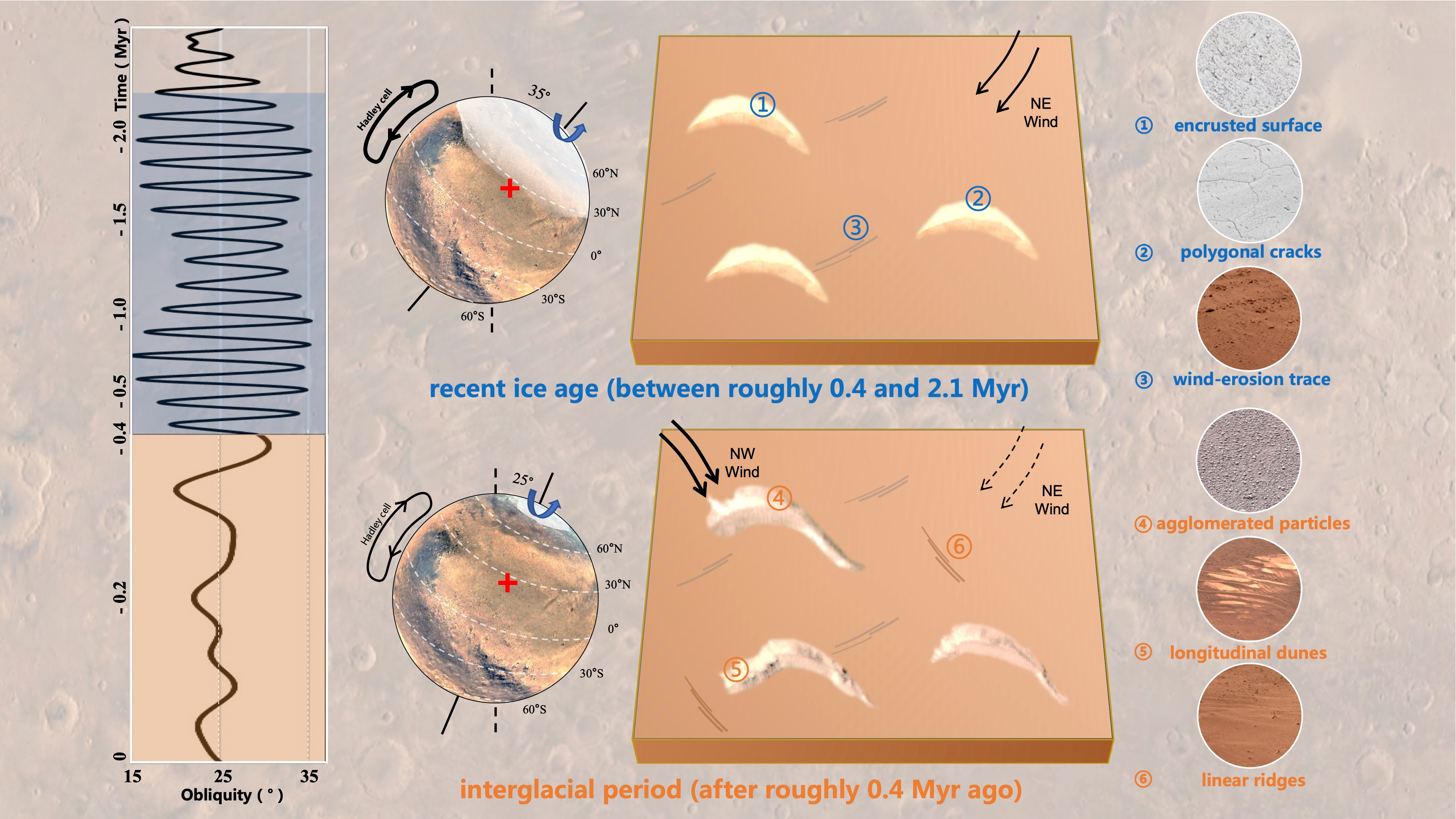The longstanding theory that Mars is emerging from an ice age has gained support from the Zhurong rover. The rover has produced evidence of a changing wind regime at just the time the Martian glacial period is thought to have ended, leaving a recognizable signal in the dunes of Utopia Planitia.
For more than 20 years, observations from Mars orbiters have built a case that Mars experienced an ice age from 2.1 million to 400,000 years ago. However, Mars is very different from Earth, and its overall cold periods involve a slight warming of the polar regions compared to the current era, more than offset by colder conditions at mid and lower latitudes.
The pattern is driven by the Martian equivalent of Milankovitch cycles, where changes to the planet’s orbit and axial tilt affect exposure to sunlight. A paper in Nature reveals a change in wind regime just at the time the more recent shift is thought to have occurred.
At the moment, most Martian ice is at the poles, where we would expect. However, during the ice ages, it reaches considerably lower latitudes. Signs of recent ice coverage were spotted from orbit, but none of the Martian landers and rovers have found any. That’s until the Zhurong rover traversed a section of Utopia Planitia covered in sand dunes.
Satellite observations led to the area being dubbed a former latitude-dependent ice-dust mantle (LDM). In other words, it was part of the expanded icecap during the previous ice age, with a mixture of ice and dust meters thick, but the ice has since melted and returned to the pole.
The dunes are of a type known as barchan, meaning they have been carved into a convex shape by winds that come primarily from one direction. Their direction indicates a north-easterly wind, but today the predominant direction is from the northwest.
Previous rovers have stuck to lower latitudes where there is more sunlight to power their solar panels, although some landers were at higher locations. The Zhurong rover landed at 25.066° N, near the southernmost edge of the northern LDM. It has crossed five barchan dunes so far in its journey, each with a dark sand crust over a bright main body.
The dark and light parts of the dune are very different – for example, the dark areas are almost twice as rough as the brighter base. Everything points to them being produced by quite different climatic conditions.

Formation of the underlying bright barchan dunes and the more recent darker crust.
Image Credit: NAOC
By counting the craters on the dunes the authors estimated their ages, with the barchans building up between 2 million and 400,000 years ago, and the dark formations being made since. These represent a good match for previous estimates of Martian climate history.
“The exploration and research on the climate evolution of Mars has been of great concern for a long time,” said Professor Li Chunlai of the Chinese Academy of Sciences in a statement. “Mars is the most similar planet to Earth in the Solar System. Understanding Martian climate processes promises to uncover details of the evolution and history of Earth and other planets in our Solar System.”
A more radical interpretation of the shift 400,000 years ago proposed the possibility that evaporating water could have contributed to the crust formation around that time.
Four hundred years of winds blowing mostly in one direction on Earth could easily erode any sand dune, and often solid rock. However, the thin Martian atmosphere means change comes slowly.
The Martian ice age coincided with a period where the angle between Mars’ axis and its orbital plane swung between 15° and 30°. More recently, it has been a more consistent 25°.
The paper is open access in Nature.
[H/T: Space.com]
Source Link: Martian Dunes Reveal The End Of Its Last Ice Age